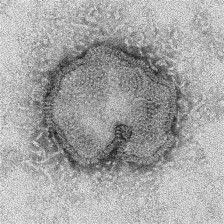WHO team probes bird flu in Shanghai

This Monday, April 15, 2013 electron microscope image provided by the Centers for Disease Control and Prevention shows the H7N9 virus which can take on a variety of shapes. Almost three weeks after China reported finding a new strain of bird flu in humans, experts are still stumped by how people are becoming infected when many appear to have had no recent contact with live fowl and the virus isn’t supposed to pass from person to person. Understanding how the H7N9 bird flu virus is spreading is a goal of international and Chinese experts assembled by the World Health Organization as they begin a weeklong investigation Friday, April 18, 2013. (AP Photo/CDC, C.S. Goldsmith, T. Rowe)
SHANGHAI – A World Health Organization team was due Monday to wrap up a trip to Shanghai, center of China’s bird flu outbreak which has killed 20 people, as part of an investigation into how the virus is spreading.
Since announcing on March 31 that H7N9 had been found in humans for the first time, China had confirmed a total of 102 cases in Shanghai and the capital Beijing as well as four provinces, the health ministry said Sunday.
“There has been no discovery of evidence of human-to-human transmission,” the ministry said in a statement.
Experts fear the prospect of such a virus mutating into a form easily transmissible between humans, which would then have the potential to trigger a pandemic.
Chinese health officials have acknowledged so-called “family clusters”, or members of a single family becoming infected, though they have so far declined to call this human-to-human transmission.
Chinese health officials and WHO representatives were to hold a news conference on Monday after the three-day visit by the UN health agency, the Shanghai government said.
The WHO representative in China, Michael O’Leary, said Friday that the purpose of the 15-member team’s week-long visit to China was to study whether H7N9 was spreading among humans.
“The primary focus of the investigation is to determine whether this is in fact spreading at a lower level among humans. But there is no evidence for that so far except in these very rare instances,” O’Leary said.
Health experts draw a difference between “sustained” human-to-human transmission and cases in which family members or medical personnel caring for the ill become infected.
The son of a man who was Shanghai’s first case of H7N9 was confirmed to have the virus after an initial test ruled it out, Chinese officials said last week.
The Shanghai government also said the husband of a woman confirmed with the virus had become sick with H7N9, but added there was not enough evidence to verify transmission between them.
“Family clusters in general do not change our understanding of the characteristics of the disease,” said Feng Zijian, an official of China’s disease control centre.
“It is still passed from poultry to people and there is no evidence of human-to-human transmission,” he said last Wednesday.














